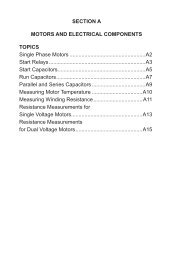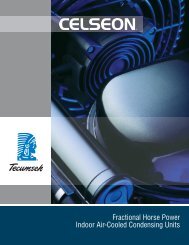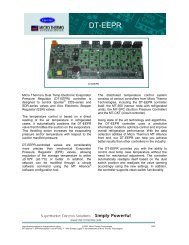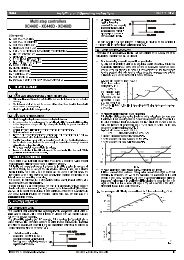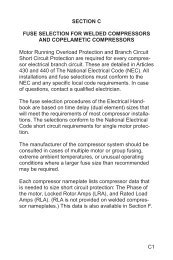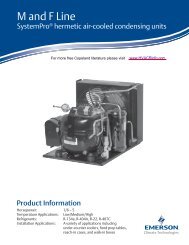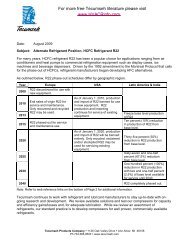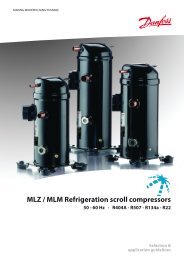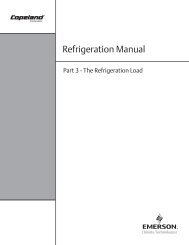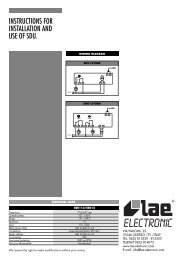Refrigeration Manual - HVAC and Refrigeration Information Links
Refrigeration Manual - HVAC and Refrigeration Information Links
Refrigeration Manual - HVAC and Refrigeration Information Links
Create successful ePaper yourself
Turn your PDF publications into a flip-book with our unique Google optimized e-Paper software.
if the evaporator temperature is to be below 32° F. sothat frost will accumulate, fin spacings of 4 per inch orless are commonly used, although closer fin spacingsare sometimes used if efficient defrost systems areavailable. In air conditioning applications, icing of thecoil is seldom a problem, <strong>and</strong> the limit on fin spacingmay be dictated by the coil’s resistance to air flow.Since the heat transfer efficiency of the coil increaseswith an increase in the mass flow of air passing throughit, high velocities are desirable. However at face velocitiesgreater than 500 to 600 FPM, water collecting on the coilfrom condensation will be blown off into the air stream,<strong>and</strong> except for specialized applications, these velocitiesare seldom exceeded.PRESSURE DROP AND OTHER FACTORS INEVAPORATOR DESIGNAs mentioned previously, pressure drop occurring in theevaporator results in a loss of system capacity due tothe lower pressure at the outlet of the evaporator coil.With a reduction in suction pressure, the specific volumeof the gas returning to the compressor increases, <strong>and</strong>the weight of the refrigerant pumped by the compressordecreases.However there are other factors which must also beconsidered in evaporator design. If the evaporator tubingis too large, refrigerant gas velocities may become solow that oil will accumulate in the tubing <strong>and</strong> will not bereturned to the compressor. The only means of assuringsatisfactory oil circulation is by maintaining adequate gasvelocities. The heat transfer ability of the tubing may alsobe greatly decreased if velocities are not sufficient toscrub the interior tubing wall, <strong>and</strong> keep it clear of an oilfilm. The goals of low pressure drop <strong>and</strong> high velocitiesare directly opposed, so the final evaporator design mustbe a compromise.Pressure drops through the evaporator of approximately1 to 2 psi are acceptable on most medium <strong>and</strong> hightemperature applications, <strong>and</strong> 1/2 to 1 psi are commonin low temperature evaporators.EVAPORATOR CAPACITYThe factors affecting evaporator capacity are quite similarto those affecting condenser capacity.1. Surface area or size of the evaporator .2. Temperature difference between the evaporatingrefrigerant <strong>and</strong> the medium being cooled.3. Velocity of gas in the evaporator tubes. In the normalcommercial range, the higher the velocity the greaterthe heat transfer rate.4. The velocity <strong>and</strong> rate of flow over the evaporatorsurface of the medium being cooled.5. Material used in evaporator construction.6. The bond between the fins <strong>and</strong> tubing is quiteimportant. Without a tight bond, heat transfer will begreatly decreased.7. Accumulation of frost on evaporator fins. Operationat temperatures below freezing with blower coils willcause the formation of ice <strong>and</strong> frost on the tubes<strong>and</strong> fins. This can both reduce the air flow over theevaporator <strong>and</strong> reduce the heat transfer rate.8. Type of medium to be cooled. Heat flows almost fivetimes more effectively from a liquid to the evaporatorthan from air .9. Dewpoint of the entering air. If the evaporatortemperature is below the dewpoint of the enteringair, latent as well as sensible cooling will occur.TEMPERATURE DIFFERENCE ANDDEHUMIDIFICATIONSince for a given installation, the physical characteristicsare fixed, the primary variable as in the case of thecondenser, is the temperature difference between theevaporating refrigerant <strong>and</strong> the medium being cooled,commonly called the TD. For a blower coil, the colderthe refrigerant with respect to the temperature of the airentering the evaporator, the greater will be the capacityof the coil.Temperature differences of 5° F. to 20° F. are commonlyused. Usually for best economy, the TD should be keptas low as possible, since operation of the compressorwill be more efficient at higher suction pressures.The amount of moisture condensed out of the air isin direct relation to the temperature of the coil, <strong>and</strong> acoil operating with too great a differential between theevaporating temperature <strong>and</strong> the entering air temperaturewill tend to produce a low humidity condition in therefrigerated space. In the storage of leafy vegetables,meats, fruits, <strong>and</strong> other similar perishable items, lowhumidity will result in excessive dehydration <strong>and</strong> damageto the product. For perishable commodities requiring avery high relative humidity (approximately 90%) a TDfrom 8° F. to 12° F. is recommended, <strong>and</strong> for relativehumidities slightly lower (approximately 80%) a TD from12° F. to 16° F. is normally adequate.6-2© 1967 Emerson Climate Technologies, Inc.All rights reserved.



